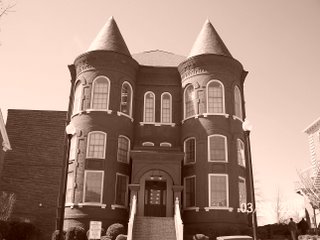We must not be living in the same country.
I saw the culture-warrior Christians in the Religious Right rallying the troops for war with Iraq.
You write as if it were the ACLU, Americans United and progressive Christians.
So here are my musings, posted as a comment on Mainstream Baptist.
Bruce says that I seem to be living in a different country. You may be on to something, so I want to experiment with that idea.
Your earlier remarks had highlighted the prominence of Reconstructionist ideas in Oklahoma. You also encounter them on the web, a place where everyone can become a published author with a little time and access.
I know these people meet and write and organize. I've taught about them in my classes. I have a colleague who researches them. But they are speaking a language that has not made much sense to my undergraduate students (a few years back) nor to my divinity students now.
Moreover, when I deal with public high school teachers and students and with college or divinity students or professors from the other universities in our area, this kind of Reconstructionist idea is the farthest thing from their view of the US. If it is true that about 40% of the people in the US go to college, as I recall (the figure I found was 35% of people at the age to start college in 2002, see http://chronicle.com/free/v52/i27/27b05001.htm, which would not include those who go later in life) then one could assume that many of these people find themselves in a milieu similar to mine. Of course, prominent Reconstructionists include many college graduates, so I am not trying to claim that going to college is an absolute indicator of whether someone would be attracted either to Reconstructionist or to Secular supremacist ideas.
A second angle to take on living in different countries could be affected by the generally progressive politics of my county and city. Maybe a better argument would be that in Durham, NC, there are not many Reconstructionists to be found (even though one prominent Baptist pastor may be in sympathy with them). Your experience in Oklahoma may be different, and no doubt Idaho has attracted such people.
One might construe the two countries according to different kinds of churches and their agendas. As for the threat of conservative so-called Christians believing in a renewed crusade, in a war to bring on Armageddon, or in a revived Imperialism of the US as the supercession of Israel, I am with you fully that this is the current great threat to peace in the US and the world. Many of these people have so many doctrines wrong about the nature of the church and the nature of the state, sadly built upon certain versions of Puritan heritage of the Reformed tradition. That is part of what I was trying to address in my earlier post about non-violence.
On the other hand, churches who are engaging in grassroots democracy and community transformation, whether conservative evangelical or progressive evangelical or mainstream protestant or Roman catholic, are recognizing the failure of conservative or liberal politics-as-usual to help the poor or deal with white supremacy. Christian Community Development, IAF/DART/Gamaliel/PICO, Leadership Foundations of America, and a variety of local churches are making changes through their own efforts and by joining efforts with others to leverage social change. That is happening all over the country, and it is something I have focused my attention on. But nowhere that I have looked have these efforts managed to eliminate poverty or racism completely.
When I look at church-state issues from the point of view of what churches must do to faithfully be the presence of Christ here and now, in this country, under this government, then part of what I want churches to know is that they don't have to accept the hemmed-in, domesticated role assigned them in the doctrine of the spheres. On pilgrimage in the world, such churches and their people engage the thrones and dominions through participatory democracy and representative government, and also by building their own structures for social change. This latter is their calling regardless of what political order they are living in--one where the secularism of eastern universities shapes the thought of many, or one where Reconstructionists can get the ear of a regional newspaper.
When I look at church-state relations from the point of view of how government policies can maintain a proper relationship toward churches and "religions," then I still find 1st amendment jurisprudence which promotes benevolent neutrality a good place to hang my hat. Neutrality will never quite be neutral, so the effort has to be asymptotic. Practical reasoning of the highest care is required. I still tell my friends they are better off not taking the "faith-based" money from the government to do their ministries. I work to stop the attack on schools that "No Child Left Behind" legislation has put in place to redirect government funds to for-profit corporations and private religious groups wanting to get in on the government purse through vouchers. But this is a defensive effort, a way to maintain detente. It is not a constructive ecclesiology. It helps keep the civil society from going too far off the path of the common good. But it does not put the church on the path of Kingdom building.
Finally, when national elections are falling out 50-50 and opinion polls are falling out 40-40, then that might be one more reason to feel that we are talking about different countries.




